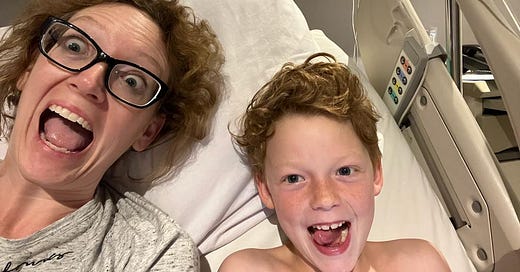Post-Dengue Reflections
More medical mayhem. Written in a caffeine-fuelled state of extreme fatigue, so buckle up, people!
Blergh… This post is brought to you by a gigantic, extra-strength cappuccino and a sincere hope that writing will help take my mind off of the monster headache I woke up with. So far, so good.
We are in the very last week of school for Bob and the two little ones. Anna’s school year finished last Friday. Someday, we are going to finish a school year in a manner that can be described as something other than “stumbling” or “limping.” Someday, we are going to sprint, or even just walk, across that finish line.
Not this year, though. It is shaping up to be the usual Koelsch family circus. But hey, it could really be a lot, lot worse, and at the very least it gives me something to write about!
The big news is that Bob and Fletcher just did a round with dengue fever. Between the two of them, I was living at the hospital for five days and four nights. Fletcher and I just got home late yesterday afternoon and, as my dear friend from the UK would say, I am totally cream crackered.
Most importantly, the boys are fine now and have made almost a full recovery. I say “almost” because they are both still exhausted and Fletcher’s platelet count is still inching its way toward normal. But we are well out of the woods, thank goodness. And as unpleasant as everything was, things never made it to the super scary point.
There have been all sorts of viruses and bugs going around in the last few months and kids in both of our school communities on the island have been sick with everything from influenza to pneumonia to COVID.
Marjorie and Fletcher have been bouncing fevers around like ping-pong balls for the past few weeks. After three kids, you have to do better than a fever to impress me. As long as you’re still eating and drinking and you aren’t turning blue, I’m just going to put you to bed with a glass of water and watch and wait. Since it is our first year in a new place, it makes sense that we are going to be exposed to a lot of new things while we build up new immunities.
Two Thursdays ago, Indonesia celebrated Pancasila Day. The Lima Asas Pancasila are the five principles laid out in 1945 by Indonesia’s first president, Sukarno, just before the country gained its independence. I’ll try to come back to this later because I think it’s really interesting to know about it, especially in the context of our trip to Java.
For now, you just need to know that Bob went to school on his day off to finish up student reports, and came home with aches and chills. He ran a fever in the night and just couldn’t get comfortable. This lasted throughout the weekend, and by Monday I convinced him to go to the local clinic and get checked out in case it was dengue.
Antibodies for dengue don’t typically show up in the blood for several days, so most doctors will just do a complete blood count to check for signs of infection and to see if your platelets are dropping. The danger with dengue is that it wipes out your platelets and can cause you to hemorrhage and go into shock. This doesn’t happen to everybody with dengue, so a lot of cases probably go undetected. The critical stage happens after your fever and aches have gone away, so unless you are showing signs of hemorrhagic fever, you probably wouldn’t be aware that anything was happening and you wouldn’t be motivated to go back for more bloodwork.
In fact, Bob may have already had dengue once in January. At the time, we thought it was dengue, but because he never had the drop in platelets we started to think in retrospect that perhaps it was Chikungunya instead (I know - so many tropical diseases to consider!). We’ve changed our minds again, but I guess we will never know for sure.
Anyway, the doctors at the local clinic will tell you that it might be dengue but they can’t be sure, and to just stay home and rest unless you start showing signs of hemorrhagic fever. And then obviously, if you start vomiting blood, you should hightail it to the emergency room. Comforting, right?
Bob didn’t start vomiting blood, and on Tuesday he fever free and feeling better, but on Wednesday he woke up with an absolutely horrendous headache. I thought he was probably just dehydrated and worn down, but I couldn’t make him comfortable. Plus, he usually fights like a bear against going to the doctor, so I knew it must be pretty bad when he asked me to take him in to get checked out.
We got his positive dengue test result about five minutes before I got a call from school saying that Fletcher was running a fever and looking lethargic. Fletcher had run a fever over the weekend (and had even run a few fevers the previous week) but had been fever-free for 24 hours and looking better, so I had sent him to school that morning despite his insistence that he didn’t feel well. Oops.
So, a rescue effort was mounted, and Fletcher was put in a Gojek with his lovely Montessori teacher’s husband and hand-delivered to me at the emergency room looking sick as a dog.
I’ve said it before, but expat communities do a fantastic job of looking out for each other when things like this happen. There was a whole network of friends and neighbors who stepped in to make sure that we were well taken care of and had everything covered. We’ve never lived near family in the years that we’ve had children, but this is what I would imagine it’s like. I’m eternally grateful for it.
I felt like a monster because they kept asking me what day Fletcher’s fever had started, and between Fletcher and Marjorie and Bob I honestly couldn’t remember who had what on which days, etc. From now on, I’m going to start recording this stuff in my calendar so I don’t look like a neglectful mother.
Because I wasn’t sure about the first day of Fletcher’s fever, they decided not to run the dengue-specific test. But based on his symptoms and blood count everyone was pretty sure that he also had dengue, and he just generally looked like hell.
Therefore, it was decided to admit both Bob and Fletcher to the inpatient ward for observation. I was hoping for a double room, but the best they could do was put us into two rooms next door to each other. This turned out to be the right choice, because a double room opened up later and I was invited to check it out, and it wasn’t nearly as nice as the ones we were in.
By the way, I now have confirmation that I was totally hosed back in October during my stay in the hospital. You know how in soccer, the Premier League is somehow better than the Championship League? Or maybe it’s the other way around? (I only just watched Ted Lasso where some of this was sort of explained to me in a way that I finally understood, despite having lived with Bob for almost 20 years.)
Anyway, that’s kind of my point. In October, I was in a VIP room and was told it was the best available room. And I believed it. And it was more than adequate.
(Listen, our pembantu Wayan’s mother has been in a rural hospital recently with complications from diabetes, and she has been sharing a room with seven other patients. Wayan and other family members have been sleeping on the hospital floor in order to help take care of her and make sure she eats. I know a first-world problem when I see one.)
As it turns out, a VIP room is not the best available. There’s a huge wing full of nicer rooms. Instead of a windowless box with fluorescent lighting, Bob and Fletcher got rooms on par with what you would find in nicer US hospitals. Adjustable lighting, adjustable beds, a foldout couch for me, and extra TV channels in English. Again, first-world problems, but if you’re going to be stuck in the hospital for a long time, these things make a difference.
Once we were admitted and hooked up to IV drips, it was just a waiting game to see if things would get ugly. Bob’s hematocrit was slightly elevated, which is a sign of plasma leakage, and his platelets were borderline low, but once we got him on IV fluids and got his headache under control it was pretty obvious that we were already through the worst of it. His bloodwork was already moving in the right direction by Thursday morning and he got sent home that afternoon.
Fletcher had a tougher run. As I said before, the “critical stage” happens right as the fever ends. His leukocytes got really, really low. His platelets dropped below normal and then lower again for two days in a row. You could actually see the effect it had on his body’s ability to clot because every morning they would come in to collect a new blood sample and afterward, he would bleed right through the bandaid. The poor little guy was so game about for the first few days, but by the end, he had had enough of playing pincushion.
Still, all things considered, he never developed anything too terrifying. And as scary as dengue sounds, most people get through it just fine. Even the ones who are vomiting blood are usually ok as long as they have access to iv hydration and transfusions if needed. Although, the fact that I am rationalizing a disease that makes you vomit blood and bleed from your nose and mouth sounds a little crazy, now that I think about it.
Honestly, aside from the blood tests, the worst part for Fletcher was the super itchy rash that he developed on his second to last night in the hospital. And even that was actually a sign that he was getting better and that his body was absorbing all of the extra fluid that had been leaking out of his capillaries. Other than that, he was happily ensconced in a comfy bed with unlimited iPad time.
He didn’t even have to get up to pee. We had to carefully track all of his fluid intake and output, so I spent a considerable amount of my time helping him pee into a jug and recording the volume of the goods. Loads of fun.
Several people have asked if this will be the final straw that sends us packing from Indonesia. We are still processing all of this, to be sure, but I don’t think it’s time to go just yet. I’m sure many of you would choose differently, and perhaps I will feel differently in the future, but somehow, dengue doesn’t feel like a deal breaker.
Dengue is so common here that most of the Balinese I know have had it at least twice. There are five different strains, and you can therefore catch it up to five times, but the second infection is usually the most dangerous. Therefore, it would be great to know if this is truly Bob’s second infection.
A vaccine is available, but only after your first documented dengue infection. In people who have never had dengue, it can actually make your first case more severe. Crazy, right? I feel like we could do better than this with a little more funding and research. Dengue is sometimes listed as a “neglected tropical disease,” which basically means that it doesn’t make the right kind of people with the right kind of money sick enough for the world to take notice. That’s frustrating.
Bob and Fletcher will likely get the vaccine. The girls and I just have to try to avoid it as best as possible. You can slather yourself in mosquito repellant here and sleep under mosquito nets all you like, but the bottom line is that avoiding mosquitos here is practically impossible. Everyone gets it eventually.
So yeah, even now, dengue doesn’t feel like the scariest thing about Indonesia. It’s so common that the doctors in the hospital were pretty blasé about it. Not that they weren’t appropriately attentive. It’s just that they are very experienced with handling it. It’s one of the few times I’d actually prefer having a Balinese doctor to going abroad.
I’m far more afraid of traffic accidents, snake bites, and the long-term effects of living in a country with such poor waste management. Living here has been incredibly eye-opening when it comes to the problems caused by single-use plastics. It’s worthy of another post, but for now, let’s just say that huge amounts of plastic waste are burned here daily. Almost daily you will walk by a field or a warung blasting out big billows of toxic fumes. Studies have shown that chickens are laying eggs full of dioxins. If you are eating eggs in Indonesia, you are eating microplastics. It’s unavoidable.
I worry sometimes about the effects of spending time here during the children’s formative years. But I’m also grateful that they get to see how complex the world is in a way that you don’t really grasp without living, or at least spending a significant amount of time, in a developing country.
To be clear, that really wasn’t our primary goal in moving to Bali. If I’m being completely honest, it had more to do with my selfish desire to travel and see the world and go adventuring before I got too old and/or suddenly dropped dead. And then of course, there’s the fact that we really like the schools here and there are real opportunities to practice “real” Montessori.
There was nothing terribly noble about our decision to come here, and I’m always a little uncomfortable with traveling families that pat themselves on the back for “showing their children the real world.” The kids are just along for the ride, and they don’t always like it.
Still, there’s no denying how much you learn, especially in a country like Indonesia. It’s relatively easy to feel gratitude for all of the things we take for granted in other parts of the world. Access to quality health care (expensive or otherwise), clean drinking water, safe roads, and infrastructure that whisks away our household waste so that we can pretend that it just ceases to exist after it leaves our trashcans and recycling bins. Relatively little government corruption and adherence to safe building practices. Passports that allow us to visit most of the world without hassles and safe (enough) countries to return to when the going gets tough abroad or we fail to attain a work visa in our desired location.
Lots of people focus on gratitude and talk about wanting their children to learn gratitude through travel. All of that is very true, very necessary, and very noble in my opinion, but I hope my children come away with more than just gratitude.
More than gratitude, I hope my children come away with respect for just how incredibly complicated the world is. It’s fascinating to see how different the needs of a developing country are as compared to the needs of a country like the United States or Australia. Understanding those needs is going to be vital to solving problems like pollution.
For example, there is currently a raging Instagram debate in Bali about overdevelopment, especially here in Canggu. On the one hand, it is pretty straightforward. The rate of construction here is just mind-boggling. It’s like living in a gold rush town. There are buildings going up in every direction and on every street and the construction goes on early in the morning until late at night, regardless of the day.
On our tiny little gang, there are at least three houses and a multistory apartment building going up around us. I don’t even notice the hammering sound anymore. It’s pretty interesting to watch the construction. It’s old-school. We’re talking bamboo scaffolding, and bricks are often made on-site. You can forget about hard hats. Often, the workers live on a site until it is finished. They build a little lean-to shack to sleep in and cook over an open fire. They hang their laundry up to dry around the site. Honestly, it kind of looks like a fun time.
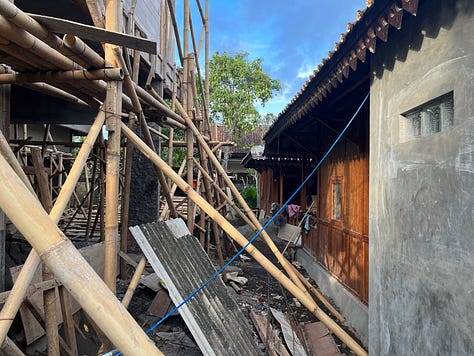

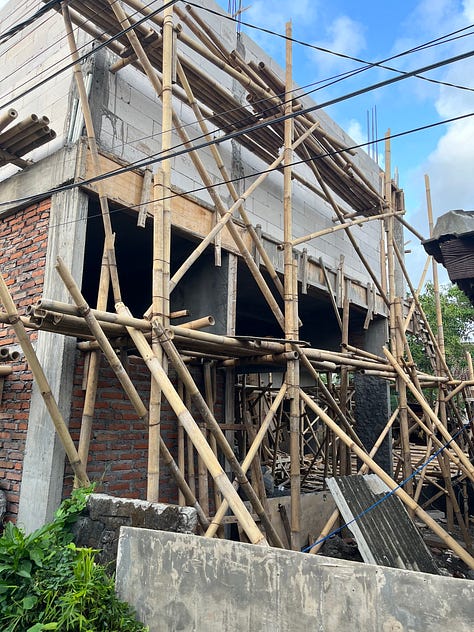
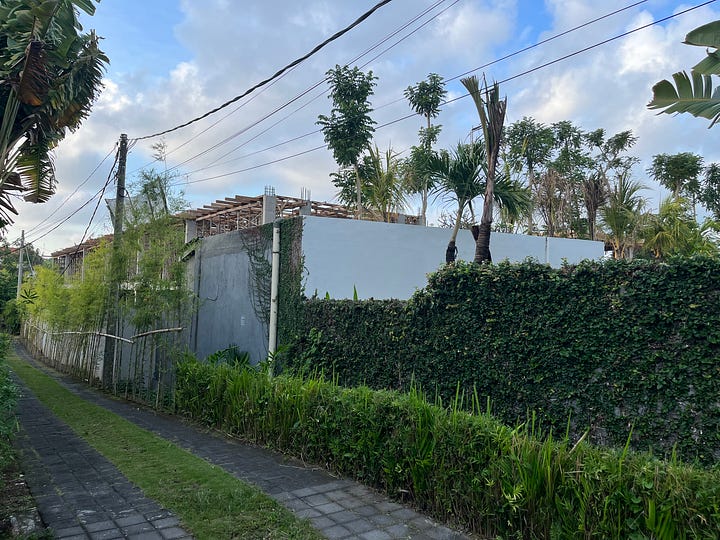
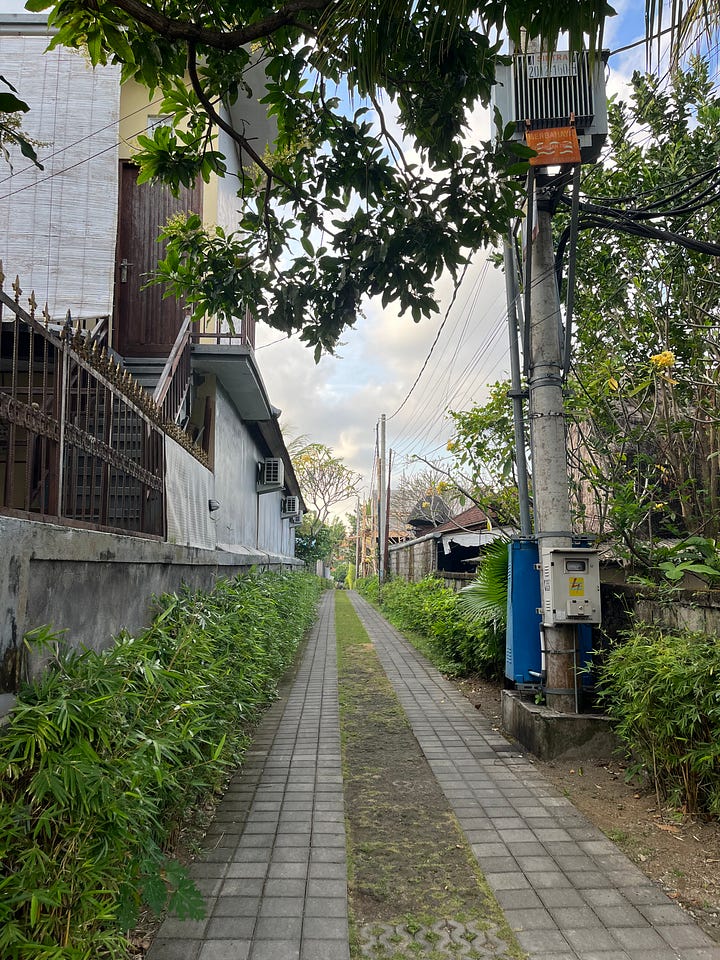
I doubt any of these guys have formal construction training. Everybody is a generalist and knows a little bit about everything, but nobody is an expert. There are building codes, but I highly doubt they are enforced. We are one earthquake away from a disaster like the one that happened in Turkey, and I solidly refuse to live in another two-story house for the remainder of my time in Indonesia. There’s a good reason that joglo-style houses were favored here for thousands of years.
If you are a Balinese landowner with a few extra rice fields in Canggu, you are sitting on a goldmine. As I understand it, as long as you don’t sell the original family compound that houses the family temple, you can sell off your rice fields without breaking any cultural taboos. That’s why you will still see family compounds tucked in between fancy Western villas and hotels and coffee shops all throughout the island. These compounds are typically built around a central courtyard and surrounded by high walls, so it’s like an invisible Balinese community exists within Canggu that you will only see if you know what to look for.
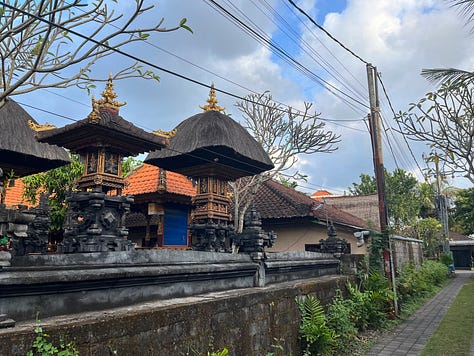
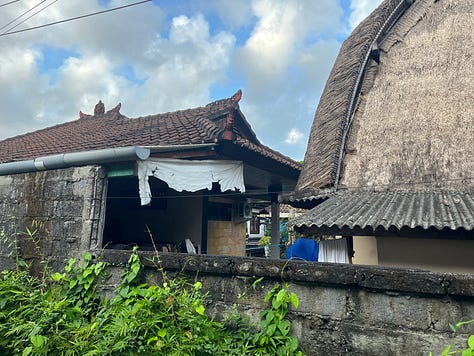

Of course, if you are moving to Bali expecting to ride bicycles past picturesque rice paddies a la Julia Roberts in Eat, Pray, Love, you are going to be pretty alarmed to see all of the beautiful rice paddies disappearing and being replaced by shitty construction. It’s not crazy to wonder about the potential for the natural beauty and culture of Bali to be lost.
But then you have to ask yourself why you would want the owners of those rice fields to keep doing back-breaking labor and subsistence farming just to preserve the view from your big bule villa. Isn’t that kind of selfish? Modern comforts for me, but not for thee?
As I said earlier, the Instagram debates are constantly raging, usually between Western expats in Bali calling each other out for being neocolonialists or reverse racists or anti-Russian and all sorts of other stuff. Are you allowed to be annoyed about your neighbor’s loud roosters or complain about all the dogshit on the beach or does that count as being culturally insensitive?
Finally, someone put up a poll asking local Balinese to weigh in on how they feel about the rapid growth on the island. The answers are interesting. A lot of people told of going from poverty to being able to afford an entirely new quality of life and even sending their children to study domestically and abroad for the first time in their family’s history. Nobody thinks the current situation is perfect, but they vastly prefer it to life in the rice fields.
So what do you do? How do you balance it all out? There’s so much money running around on the island right now that it’s getting crazy. Several of our friends are looking for housing at the moment and telling stories of people showing up to inspections with literal bags of cold, hard, cash in an attempt to outbid each other.
People will build a villa anywhere they can squeeze one in hopes of renting it out for profit. Our school owns a large empty lot that we use for parking and arrivals and dismissals. The owners of the adjacent lots have been warned not to build villas with the expectation of using the field as an entrance. We may develop the land in the future, and there isn’t enough of an easement to provide them with car access to their lots.
Of course, here in Bali, rules are for suckers, and you just need to know who to pay off to get around the rules on a given day. So a few villas went up, and then a few more, and more are still being built. They all have big, beautiful two-car garages facing out into our field. To make matters worse, they started complaining about their “driveways” getting muddy from all the school traffic during drop-offs and pick-ups.
Finally, the school got fed up with this nonsense, and so a few days ago they started building a wall along the property line. And the property line runs pretty much flush against the garage doors. They certainly won’t be parking any cars in there, and I’m not even sure that they will be able to fit a motorbike in there when it’s done. It’s pretty funny in a mean, “pass the popcorn” kind of way.
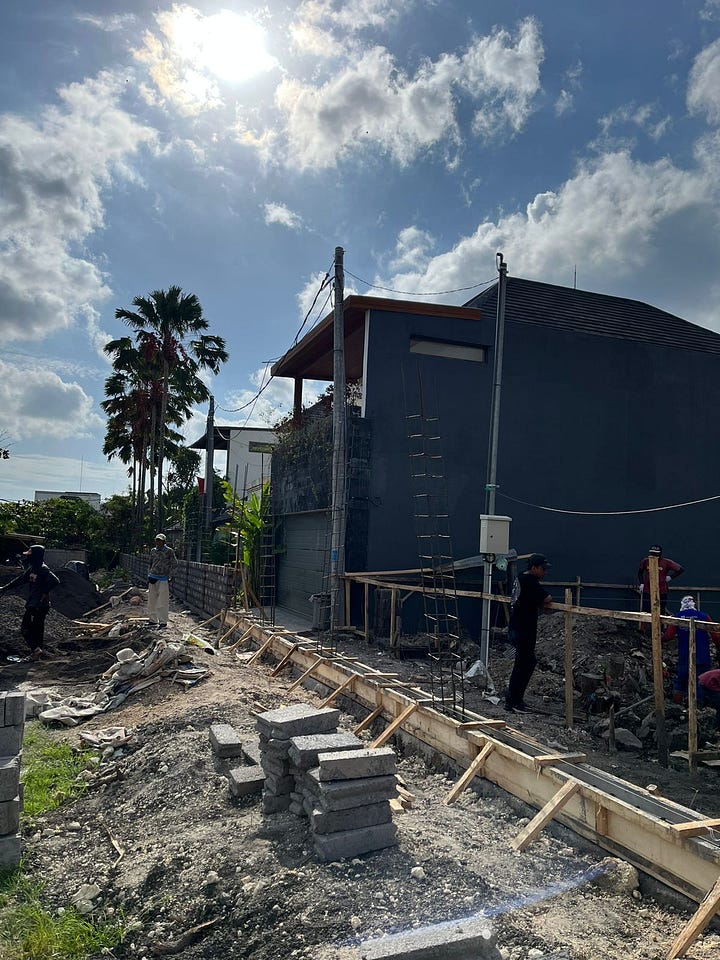

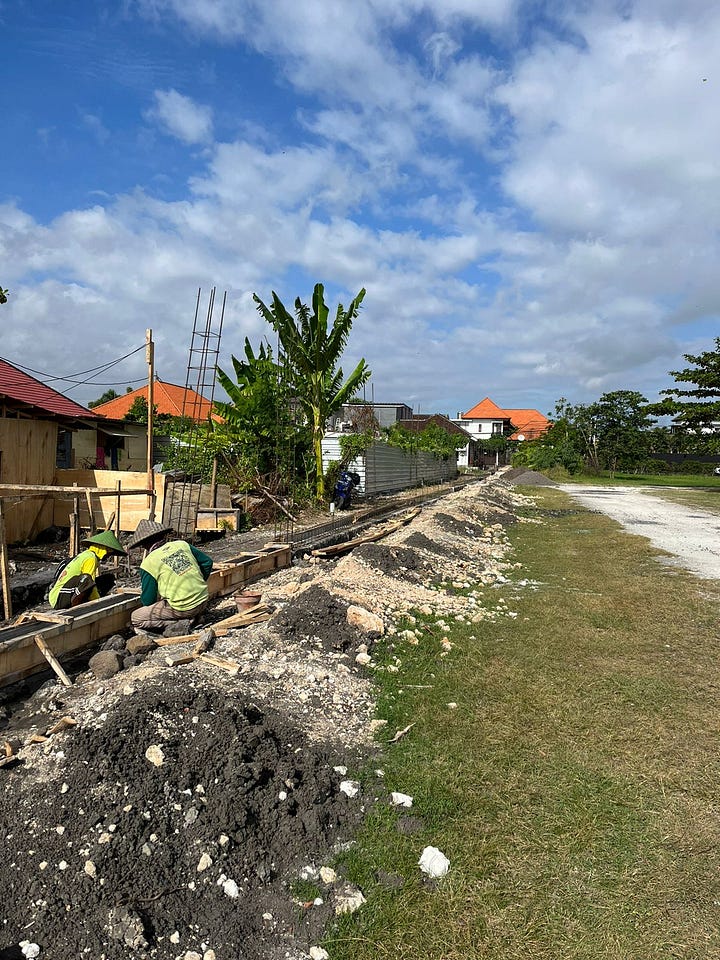
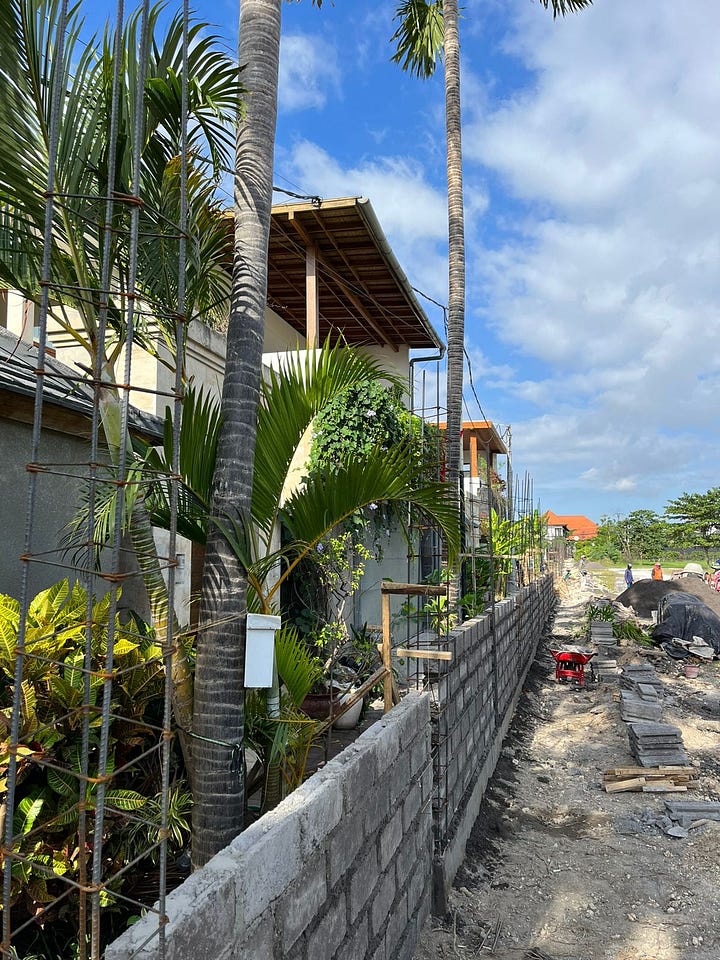
Even if you aren’t silly enough to build a garage with no road access, you can still get into trouble with zoning laws changing right out from under you. The local banjars (kind of like a local government) control which areas are designated as red, yellow, or green zones for development. But the banjars aren’t elected (it’s more like a dynasty), are highly subjective, and can change their minds about zoning at will. If you previously had an agreement with the head of the banjar, that can all get thrown out the window when and if he dies and is replaced by a new guy that doesn’t like you.
Sometimes, the local banjar stands in the way of what seems like progress. There have been several efforts to encourage recycling on the island and a few companies have sprung up that will collect your recycling for a small fee and supposedly make sure that it all finds its way to the appropriate facility. Most new expat arrivals to Bali sign up for this, ourselves included because it seems like the obviously responsible thing to do. And I’m not suggesting that it isn’t!
But the local banjar in Pererenan, just to the north of Canggu, has forbidden the recycling companies to collect trash in their area. It’s one of those things that people have been discouraged from pursuing with the banjar for fear of getting on their bad side, and everyone considers it a big scandal.
Here’s what I think is actually going on. I think the banjar is actually trying to protect the interests of the local waste pickers. Being a waste picker is an actual vocation in Indonesia (and other parts of the world), to the point where they have actually formed a global alliance for representation.
Here’s what happens to your trash in Bali, assuming you don’t pay for recycling and just let the local banjar collect it en masse. All of it goes to the local dump, and then it is picked through with a fine tooth comb by the local scavengers. They know better than anyone what can actually be recycled for profit, and they collect it, sell it to the recycling plants, and use that money to support their families.
In fact, during the pandemic, many of these waste pickers nearly starved because there wasn’t enough trash being produced by tourism and because of the decreasing prices of oil. Here’s a little mini-documentary I found that talks about it.
So in a weird way, Bali does have a recycling program, but you wouldn’t recognize it as such if you come from a country where you are used to sorting your trash at home. And you can understand why the local waste pickers in Pererenan aren’t keen on having their livelihood stolen by a recycling company from another part of the island.
Of course, there's still the problem of waste that can’t be collected for profit, but that’s an entirely different kettle of fish. And it’s way too big of a kettle to get into right now. But hopefully, I’ve been able to explain a little of what I meant about the world being complicated. By all means, let’s get rid of plastic water bottles, but doing so has implications for some of the world’s most vulnerable people.
I’m starting to think that tackling poverty is probably the biggest single thing we can do to solve problems like deforestation and pollution and overdevelopment. Easier said than done, and it makes me wish sometimes that I knew more about global economics.
In fact, when I was in high school, a friend told me that she was majoring in economics and I said something incredibly stupid about how boring that sounded. At the time, I thought economics had more to do about banking and wall street and was only for people interested in making lots of money for personal gain. Obviously, I was a bit of an idiot back then, especially when it came to understanding just how important money is whether we like it or not. I still think finance sounds boring, but I appreciate how important it is to understand these things if you are trying to make real changes in the world. If one of my kids tells me they want to study economics or even finance, I’m going to be happy for them.
In the meantime, I hope it was enough to do my part as an educator (and now as a parent) to help children learn just how complex the world is, and to appreciate all the different sides of the issues. Bake sales are cute, and it’s all fine and good to be instilling kids with passion and heartfelt sentiment about “‘the issues” but to really solve the world’s problems these kids are also going to need to know their math and science and be able to write bang-up grant proposals and research papers.
And that’s why I’m forever hammering on about the need for high standards in education and solid academics.
Well, I’ve been on my soapbox for a while now and it’s probably time to wrap this up. Thanks for sticking with me, if you made it this far. Here’s what happens if you give me caffeine and a keyboard!
And if it floats your boat, here is a link to a pretty hilarious reel about the over-development of Canggu from one of the local meme pages. It’s a bit off-color, but it is pretty accurate in a gallows humor sort of way. The road at the end of the video is the infamous Canggu shortcut that we ride through almost every day.
If all goes well, we are going to visit Malaysia next week. Bob’s family spent some time in Kuala Lumpur when he was young and he would like to go and check out the old stomping grounds. That’s going to be our big “summer” trip (although, technically it is winter here. We will spend the rest of the school holidays exploring Bali and hanging out at home. It will be nice to catch our breath, now that we have almost one year under our belts.
I’m planning to thoroughly enjoy the last quiet week before everyone finishes school, and if all goes well I will get to do a lot of writing. I still owe you the details of our trip to Java! I’ve sat down on at least a few other occasions to write it, but something else always finds its way onto the page.
Stay tuned!

